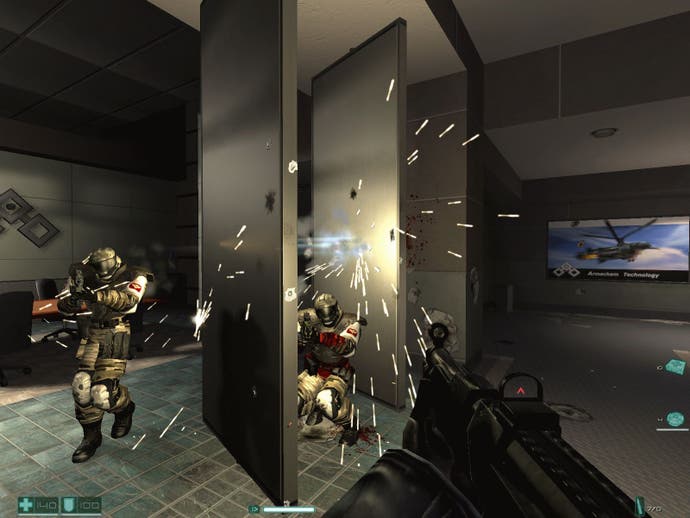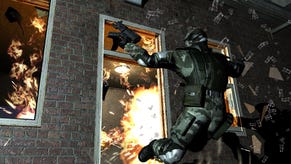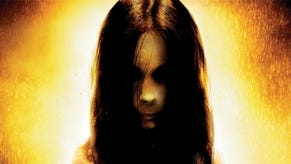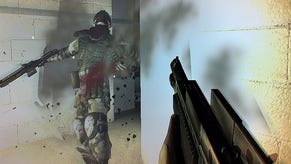F.E.A.R.
Frighteningly good.
There's a quote I've got stuck to the outside of my monitor, which, while borderline fruity, is something I always enjoy reading. It goes, "The art of punctuation is of infinite consequence in writing; as it contributes to the perspicuity, and consequently to the beauty, of every composition." Glancing at it again this morning, it struck me that that's precisely how FEAR behaves. It's a game that seeks to embolden action sequences through the lucidity of slow motion, and with help from technology that taps deep wells of environmental detail consequently beautifies the composition in ways that nothing else can. Nothing. Not even Half-Life 2. Good quote, that - I'm glad I stuck it over the top of the "I OWN YOU!" sticker.
FEAR's biggest trick is its first-person, slow motion gunplay, which, while the game at least attempts to justify it, is basically there to make things more fun. And it does. It fuels relentlessly explosive gunfights that always end messily. Whenever you hear the telltale comms chatter of Replica forces, you're alert, and as soon as the first enemy bullet leaves its barrel you react by jamming on the Shift and Ctrl keys with your little finger to peer down the sights and activate your "Reflex" slow motion, sliding the game under visual and audio filters that sharpen edges and dampen sounds, and you dispatch bullets thud by thud into the groooaning ragdoll shock troops that lie ahead of you. Escalation of this core combat is relatively minimal, with only a few enemy types that exceed the basic military clone class (the most damaging of which you only encounter a couple of times anyway). New weapons uniformly excite (particularly the nail-people-to-the-walls Penetrator, but also the MP-50 heavy cannon, the machine sniper rifle and railgun-esque incinerator effort, and the satisfyingly meaty shotgun), but the hook here is the slow motion gunplay itself, not the circumstances. You'll have much less fun trying to win without it.
Clarity is a very difficult thing to achieve in an interactive action sequence - particularly in a traditional first-person shooter, where the player stands the greatest chance of looking the wrong way. Here the slow motion accentuates every little disintegration and shard of glass in a way that exceeds Max Payne's achievements in gifting games a noticeably filmic quality with its concert of doubly high definition. On harder difficulty levels, you'll have to replay key encounters several times over until you've written the perfect script in slow motion, watching bodies twist and buckle as bullets thud-thud-thud into their torsos, loving the way funnels of glass erupt as bullets pierce windows, marvelling at the bubble of blood-mist and shrapnel that grows from the impact of a well-aimed grenade or bullet loosed into an explosive barrel. The definition of the visuals is laudable in itself, but when played out on high-end hardware - which is a pre-requisite - they play an even more vital role in your enjoyment. It's so detailed that you really do have to wait for the dust to settle.

Mind you, the engine's artistic impact is less than you might expect. Really the function of the graphics is to lessen the burden that traditionally rests on your imagination during commonplace FPS encounters, and its use outside of that is often functional at best. You could argue that that's disappointing; that such an industrious engine, capable of running your GPU like a scouring pad across the lining of the frying pan you've just peppered with an assault rifle, ought to be put to more exotic use than it has been in the largely dark and grey industrial settings that make up FEAR, but in truth as long as the core action doesn't outstay its welcome it's reasonable enough; and it doesn't. Every step of the way this is about the same sort of combat and its incidental impact. It's got helicopters and dust clouds, sure, but don't expect to sit on a sand dune and watch the morning sun ease a rippling course over the hazy horizon and you're fine. That said, if there's a criticism here, it's that outside the combat the environmental detail too often boils over into inconsequential detail - with countless office cubicles to explore for nought but the occasional quirky in-joke.
FEAR's horror influences have been billed as its other defining facet. The story itself concerns a paranormal assault team - the paradoxically monikered First Encounter Assault Recon - set on the trail of a rogue psychic commander of military clones, and your pursuit of him as he directs his force against its maker. That objective persists for more or less the entire game, but over the course of it your shared psychic characteristics contribute to occasionally startling and confounding events. The use of sharp pangs and unsettling overtures, flashbacks and other psychological teasing is most prevalent, as is the game's bent, with Doom III-style "BOO!"s kept to a relative minimum. When they do occur, they're often unexpected, which heightens the excitement. Doom, incidentally, may be directly comparable in terms of the uniform setting, the game's tendency toward hunting in the dark (with a flashlight you can bloody well hold at the same time as your gun), and its love of the paranormal, but FEAR's direction and action sequences conquer id Software's effort in close to wholesale fashion.

That said, the story itself, while it knots itself together at the end in a manner that's been suitably prescribed by events up to that point, is only compelling for those prepared to overlook its shortfalls. The climactic events are enjoyable - and distinctly memorable - but the use of horrible sights and sounds is far better than the actual plot, which ultimately rings a little hollow, and the storytelling itself. FEAR gradually explains itself through company voicemails stored on phones in offices, and information gleaned from the occasional distinctive laptop that your squad coordinator then relates to you over comms. The secondary cast and things they do never really escape cliché (there's not an Alyx or a Carla Valenti among them), but they do nudge things along sufficiently, while your silence is occasionally frustrating but generally appreciated. In the end, for all its professed Asian horror influences, FEAR's is a very Western exposition, more reliant on spooks than actual narrative quality - the finest bits being the blurry, leaden-footed flashbacks that gradually become more articulate as you near the end, climaxing in a kind of cross-over between the real and psychosomatic.
Which pretty much sums up the game, truth told. Exploration is light, and puzzles are rare and forced (often obviously manufactured too. Why can't I just climb through this broken window to reach that valve? Why can't I just move this wooden crate myself instead of having to float it clear of the exit?); the real guts of the game is creeping around heavily patrolled office and industrial environments with a torch, getting into slow motion gunfights, and occasionally having your brain invaded. Ultimately the combat and horror licks are absorbing, but it's very contrived in places - when you see that the game's checkpointed your progress, you'll worry about that little side room you didn't check for bonuses; environmental interaction is really very limited; and there are so many barred doors and staple FPS rails running along the side. It's a testament to the action that you won't care - you're probably having to fill in as many imaginative blanks as you do in any other solid FPS game, but here the distinctive, measured combat dynamic means it feels fresh and compelling by comparison.

It's worth pointing out that multiplayer does feature with deathmatch, capture the flag and so on - and its most notable achievement is the addition of a slow-motion power-up, which lets one player take on crowds of others who move as if stuck in treacle - but in the absence of anything genuinely innovative its meaty weapons and claustrophobic level design will probably only satisfy briefly, since we have well-developed playgrounds for this kind of thing already. Better to take on the Replicas.
Played on one of the higher band of skill settings, your AI opposition are really given the chance to shine. If you pitch in at a difficulty level where you feel relatively superhuman over the first half an hour or so, you might want to start again on a harder one. FEAR's at its most intense and satisfying when you can't wipe the enemy out in one runthrough of your Reflex bar, forcing you to regroup. When you run out of Reflex, the sheer velocity of rifle rounds is shocking and unmanageable, so you spend more time trying for that Bruckheimery finesse through judicious use of quick-saving and -loading. Your Reflex recharges relatively slowly, but armour and healthpacks in particular are abundant (and you can store up to ten of the latter, effectively boosting your health capacity - which is boosted in itself by little syringe guns stashed behind grates and through crawlspaces), while enemies are smart enough not to chase you through chokepoints, so you tend to be quite comfortable. Unthreatened you're... well, Word suggests "without fear" as a synonym. Pretty apt. Forced to make the most of your assets against opposition that can tear environmental obstacles out of their paths, vault low walls and flank you through little side-passages and chase you down, it's brilliant. Otherwise, it's merely very enjoyable.

FEAR's certainly capable of some memorable moments. Escorting a key character upstairs in an elevator and realising that Replica elites are hitting the Call buttons to stop you on the way; searching for a ringing phone in the hope of revelation and discovering a tragicomic truth; being chased down narrow alleyways by armoured trucks; your first encounter with the heavier opposition; the way the game handles the inevitable endgame confrontations and denouement so unusually... But ultimately this isn't a game of specific set-pieces, it's a game about making your own.
Right now, doing that is glorious fun. Slow motion gun battles tied to an engine that articulates carnage with the furious eloquence of a caffeinated linguist, bound together by people who've seen a lot of Asian horror, uniting to spread memorable moments over a bed of visceral excitement. Were it not for its time manipulation though, it would suffer - and certainly can't compare to Half-Life 2's timelessness on that basis. Buy it because it's a glorious novelty that won't wear off for its duration, but do expect things to move past it in the coming years. For now, it's worth celebrating because it's put the fun back into FPS punctuation.





